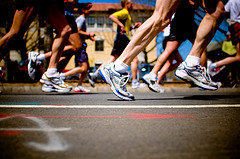 Runners take note: running in the right pair of shoes is important for injury prevention. There are many types of shoes on the market, from the most supportive via motion control to the least supportive, as in the new barefoot running trend. “So, what shoe do you recommend?” There isn’t a simple answer. Shoes are your connection to your running surface, and I absolutely believe finding the right one for you is important.
Runners take note: running in the right pair of shoes is important for injury prevention. There are many types of shoes on the market, from the most supportive via motion control to the least supportive, as in the new barefoot running trend. “So, what shoe do you recommend?” There isn’t a simple answer. Shoes are your connection to your running surface, and I absolutely believe finding the right one for you is important.
First, here’s a few basic tips…
- If you are serious about running, go to a store that specializes in running shoes and has knowledgeable staff. The staff should ask you about how you train and your mileage.
- Old shoes are a high risk factor for the development of running injuries. Change them out at around 300 miles.
- When you pick up the shoe, try to bend and twist it. If it looks like you can squeeze it like a towel, it doesn’t have much support and could lead to overuse injuries. Get new ones or buy different ones.
- Get the right size. Your foot swells by 1/2 to 1 whole size when you run, so get measured. Don’t end up like these guys.
- Before you buy the shoe, run in them. It’s not enough to stand or walk, because that’s not what you’ll be doing in them.
I value my skills in analyzing foot arches, resting joint positions, and torsions (rotations) of the bones in the lower legs when assessing posture of a runner. I would like to think the findings of such a postural assessment is the most important consideration in the decision-making process when shopping for shoes. I recently attended a good running biomechanics course presented by Bryan Heiderscheit, PT, PhD, Director of the University of Wisconsin Runners’ Clinic. In the course, research was presented that shows that static leg and foot alignments are not the most significant factor for injury prevention.1 Research indicates that perceived comfort may be the most important aspect of picking the correct, injury preventive shoe.
 The way your body responds to different shoe designs is not necessarily dependent on your arch type – flat (pronated) versus high (supinated).2 The research findings were conflicting, showing different responses to the same shoe between people of similar foot types. These findings emphasize the importance of evaluating running mechanics and style for each individual. When a PT evaluates running mechanics, they are looking at stride characteristics and alignment of the knee, hip and ankle, and trunk positioning at different times in the running cycle. The way each of us moves and the muscles our body chooses to utilize are unique and are not necessarily dependent on our foot type or static alignment. If you’ve ever watched people run, you can appreciate the MANY different styles and preferences of running. Also, use of inserts that are perceived to be more comfortable have been shown to reduce stress fractures and pain compared to no inserts in research by Mundermann et al. in a study of the military population.3
The way your body responds to different shoe designs is not necessarily dependent on your arch type – flat (pronated) versus high (supinated).2 The research findings were conflicting, showing different responses to the same shoe between people of similar foot types. These findings emphasize the importance of evaluating running mechanics and style for each individual. When a PT evaluates running mechanics, they are looking at stride characteristics and alignment of the knee, hip and ankle, and trunk positioning at different times in the running cycle. The way each of us moves and the muscles our body chooses to utilize are unique and are not necessarily dependent on our foot type or static alignment. If you’ve ever watched people run, you can appreciate the MANY different styles and preferences of running. Also, use of inserts that are perceived to be more comfortable have been shown to reduce stress fractures and pain compared to no inserts in research by Mundermann et al. in a study of the military population.3
If you’re a runner and are looking for the perfect pair of kicks, you shouldn’t base your decision on your arch type alone. Having a knowledgeable professional, such as a physical therapist, evaluate your legs’ resting and dynamic biomechanics is definitely the place to start. Make sure the person making shoe recommendations not only checks stationary foot posture, but also watches you RUN in the recommended shoes. Some shoe stores, like Performance Running Outfitters, watch you run before buying. Ultimately, though, if your body isn’t comfortable in the recommended shoe, keep running around until you find the perfect fit.
- Heiderscheit, B. (2009). “Running Biomechanics: Evaluation and Treatment Strategies.” presented October 8, 2009 at the Wisconsin Physical Therapy Association Fall Conference, Middleton, WI. [↩]
- Butler et al. (2006). Interaction of Arch Type and Footwear on Running Mechanics. J Sports Med. December 2006 vol. 34 no. 12 1998-2005. [↩]
- Mundermann et al. (2001). Relationship between footwear comfort of shoe inserts and anthropometric and sensory factors. Medicine and Science in Sports and Exercise: November 2001 – Volume 33 – Issue 11 – pp 1939-1945. [↩]










October 23, 2009
General Information, Running, Sports Medicine